Fastest rise in activity in almost two-and-a-half years


The rise in output reflected a second successive and marked increase in new business, with new export orders expanding substantially again.
However, input costs continued to rise sharply and output prices increased to their greatest extent since August 2008.
Advertisement
Hide AdAdvertisement
Hide AdBut, while the private sector ended the year on a high, the report said the data concealed contrasting performances as retail and manufacturing enjoyed much stronger sales, construction firms were in contraction mode in three of the four quarters last year.
The services sector continued to grow at a rather subdued rate, with 2016 well below the growth rates achieved between 2003 and 2007, it added.
“The Northern Ireland economy begins 2017 with significant momentum, albeit the retail sector is largely driving this growth,” said Ulster Bank’s chief economist in Northern Ireland Richard Ramsey.
“However, inflationary pressures and benefit freezes will act as speed bumps for consumer spending and economic growth this year.
Advertisement
Hide AdAdvertisement
Hide Ad“The economy also faces stiff political challenges at home and abroad. It appears that politics rather than the economy will be the number one priority locally, nationally and indeed internationally for the foreseeable future. Against this backdrop, the Northern Ireland economy will do well to avoid stagnation in 2017.”
The latest report also reveals that firms increased staffing levels at a faster rate than the previous month and that order books are their most buoyant since September 2014, with demand from export markets notably stronger than domestic orders.
Export orders eased back from November’s record high but Q4 still represented the best quarterly figure since the survey began.
“Sterling weakness is a key factor in this, and has been a key theme in 2016, particularly following June’s referendum,” said Mr Ramsey.
Advertisement
Hide AdAdvertisement
Hide Ad“This has been largely responsible for the three key developments during the year – relating to exports, retail, and inflation.
“The record rates of growth in export orders in H2 2016 has been accompanied by the strongest set of quarterly retail sales figures in the survey’s 14-year history.
“Demand from the Republic of Ireland is boosting exports and retail sales considerably.
“The downside of having a competitive exchange rate is import price inflation, and retailers and manufacturers have borne the brunt of input cost inflation.
“This is being passed onto consumers with retailers and manufacturers increasing prices in Q4 at their fastest rate on record.